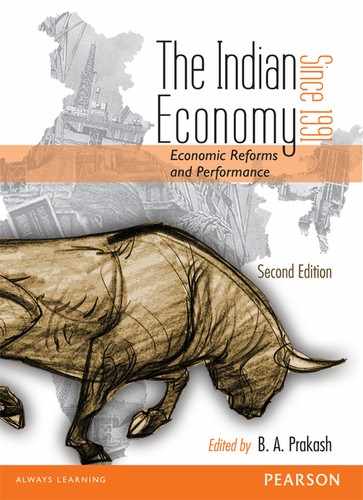Chapter 13
1. The extent of anti-export bias in the trade and payments regime can be gauged by the fact that in 1985–86 the merchandise exports accounted for only 4.1 per cent of GDP, while the imports were running more than 80 per cent higher at 7.6 per cent of GDP, entailing a trade deficit of 3.5 per cent of GDP (Acharaya, 2001).
2. It was argued that the BoP crisis originated from the structural inadequacies and problems within the economy. According to IMF-World Bank strategy, this can be corrected only through a long-term structural adjustment programme. The similar view is due to Bhagwati and Srinivasan, who argued that the macro-economic crisis in India basically originated from the ‘micro economic’ inefficiencies that distorted the structure of the incentives to the producers.
3. India was committed to eliminate the exchange controls on the current international transactions as a part of the structural adjustment policy and liberalization to manage the BoP problems.
4. The current account transactions include payments due in connection with the foreign trade, the current business including services and the normal short-term banking and credit facilities; payments due as interest on loans and as net income from other investments; payments of moderate amount of amortization of loans or for depreciation of direct investments; and moderate remittances for family living expenses.
5. The invisible items are classified into two categories, namely, the factor and non-factor income. Factor income includes remittances of interests, dividends and work compensation (private remittances). Following RBI non-factor services includes travel, transportation, insurance, government and miscellaneous services. The software, global back-offices, media, consultancy and other technology-related services include miscellaneous services.
6. As a part of the Agreement on the Trade Related Intellectual Property Rights (TRIPs), the Presidential Ordinace on 8 January 1999 granted Exclusive Marketing Rights (EMRs) in the field of pharmaceuticals and agricultural chemical products pending the adoption of product patent in 2005. Further, as a part of the globalization process, the Trade Related Investment Measures (TRIMs) were notified by the Government of India.
7. India generally adopted a highly regulated regime in the arena of foreign investment. This policy was little eased first with a change in the industrial policy regime in India. The major policy decision regarding the foreign direct investment was made in the New Industrial Policy of1991. Only after this, the norms and procedures regarding the FDI have been declared to liberalize the foreign capital flows.
